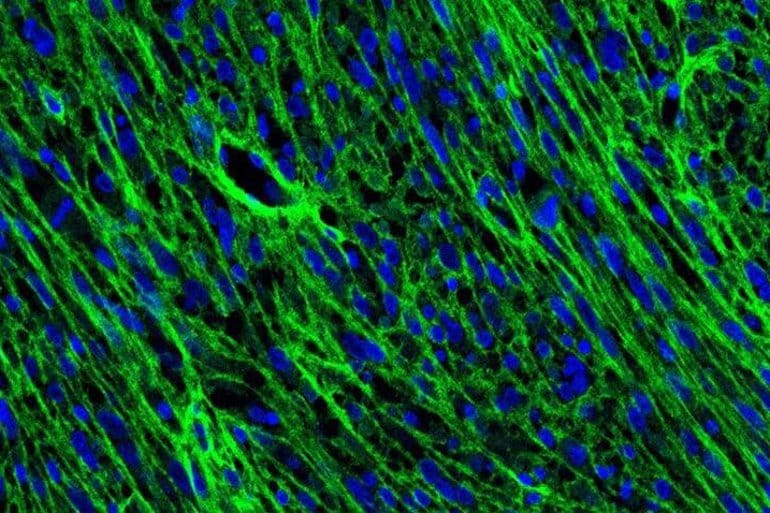Summary: Eliminating Collagen 1 production in tumor cells allowed animal models of brain tumors to live longer.
Source: University of Michigan
Tumors are made up of many types of cells, both cancerous and benign. The specific complexity of the cells inside brain tumors has been a trademark of the disease, one that makes treatment extremely difficult.
While scientists have long known about the variety of cells within a brain tumor, the ways these tumors grow has relied on the understanding that the cells are static, unmoving and relatively fixed.
But researchers at the University of Michigan Rogel Cancer Center have discovered that these aggressive tumors contain highly active cells that move throughout tissue in complicated patterns. What’s more, the accumulations of these elongated, spindle-like cells found throughout the tumor, coined ‘oncostreams,’ serve as the basis for cancerous cells’ behavior, determining how tumors grow and invade normal tissue.
Pedro Lowenstein, M.D., Ph.D., Richard C. Schneider Collegiate Professor of Neurosurgery and lead author of this study in Nature Communications, says this organized growth is what makes brain tumors so relentless.
“Brain tumors are highly lethal, with less than 5% of patients living beyond five years,” he said. “Unfortunately, reoccurrence is what eventually kills patients. They receive surgery for their initial tumor, but the tumor always comes back within 12 to 18 months,” he said.
Lowenstein and his team, including Maria Castro, Ph.D., also found that overexpression of Collagen 1, a protein produced by tumor cells, is essential to the growth and function of these structures.
“When we eliminated Collagen 1 production from tumor cells, the animal models with brain tumors lived much longer. This step removes oncostreams from tumors and reduces tumor aggressive behavior because the tumors need Collagen 1 to move in the specific way we discovered,” said Lowenstein.
Lowenstein says this structure is likely present in other types of cancer, too. “Once people recognize that there are dynamic areas of the tumor, and that they’re related to tumor growth, eventual invasion and death, people will likely locate oncostreams in other tumor models,” he said.

To detect this previously unknown presence of oncostreams, the team collaborated with Todd Hollon, M.D., assistant professor in the Michigan Medicine Department of Neurological Surgery, and Sebastien Motsch, Ph.D., associate professor of mathematics at Arizona State University, to implement artificial intelligence methods to identify the structures in tissue.
“Essentially, we showed images to a computer and the computer eventually learns to recognize oncostreams,” Lowenstein explained.
Dismantling oncostreams through the removal of Collagen 1 could represent a novel therapeutic target to treat lethal brain tumors. “This research proves the crucial importance of continuing to investigate the complicated extracellular matrix,” notes Andrea Comba, Ph.D., research investigator and first author of the study.
“Based on this discovery, we propose targeting tumor collagen to disrupt oncostreams, and as novel therapy for the treatment of brain glioma,” she said.
About this brain cancer research news
Author: Anna Megdell
Source: University of Michigan
Contact: Anna Megdell – University of Michigan
Image: The image is credited to Pedro Lowenstein
Original Research: Open access.
“Spatiotemporal analysis of glioma heterogeneity reveals COL1A1 as an actionable target to disrupt tumor progression” by Pedro Lowenstein et al. Nature Communications
Abstract
Spatiotemporal analysis of glioma heterogeneity reveals COL1A1 as an actionable target to disrupt tumor progression
Intra-tumoral heterogeneity is a hallmark of glioblastoma that challenges treatment efficacy. However, the mechanisms that set up tumor heterogeneity and tumor cell migration remain poorly understood.
Herein, we present a comprehensive spatiotemporal study that aligns distinctive intra-tumoral histopathological structures, oncostreams, with dynamic properties and a specific, actionable, spatial transcriptomic signature.
Oncostreams are dynamic multicellular fascicles of spindle-like and aligned cells with mesenchymal properties, detected using ex vivo explants and in vivo intravital imaging. Their density correlates with tumor aggressiveness in genetically engineered mouse glioma models, and high grade human gliomas.
Oncostreams facilitate the intra-tumoral distribution of tumoral and non-tumoral cells, and potentially the collective invasion of the normal brain. These fascicles are defined by a specific molecular signature that regulates their organization and function.
Oncostreams structure and function depend on overexpression of COL1A1. Col1a1 is a central gene in the dynamic organization of glioma mesenchymal transformation, and a powerful regulator of glioma malignant behavior. Inhibition of Col1a1 eliminates oncostreams, reprograms the malignant histopathological phenotype, reduces expression of the mesenchymal associated genes, induces changes in the tumor microenvironment and prolongs animal survival.
Oncostreams represent a pathological marker of potential value for diagnosis, prognosis, and treatment.






